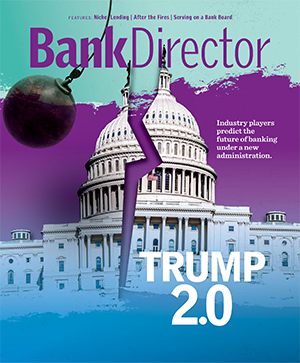
Capital, Digital Initiatives Set De Novos Up for Success
In 2018, Matt Pollock and a group of business leaders and experienced bankers organized a new bank to fill a gap they saw in the Oklahoma City market. And he believes their tech-forward approach sets them apart from competing financial institutions.
“A lot of [banks] fall into the same traps in how they approach client services and products and relationships, and they just don’t do a very good job,” says Pollock, the CEO of $110 million Watermark Bank, which opened its doors in January 2019. “So, we really focused on [building] the right team, with the right model that really drives the business community.”
Few de novo banks have formed since the 2008-09 financial crisis. Of the 1,042 community banks chartered in the eight years preceding that crisis, 13% failed and another 20% were acquired or liquidated, according to a 2016 Federal Deposit Insurance Corp. study. Overall, de novo banks accounted for 27% of all failures from 2008 to 2015, and exited at double the rate of small, established banks.
De novo institutions are particularly fragile: They don’t tend to be profitable in their early years as they invest in building their business and reputation in their markets. In today’s environment, low rates pressure net interest margins, exacerbating these challenges.
With that in mind, Bank Director used FDIC data to analyze the 24 de novo banks formed from January 2017 through December 2019 to understand how they’re performing today and how they might weather the current economic downturn. We examined efficiency, through the overhead and efficiency ratios, and profitability, through return on assets and return on equity, as of Dec. 31, 2019. We also included equity capital to assets and net interest margin in the analysis. Watermark came in fifth in our ranking.
Today’s batch of de novo banks features higher capital levels, a requirement that has dampened new bank formation. (The FDIC doesn’t set a minimum capital threshold for de novo banks; expectations vary based on the bank’s market, size, complexity, activities and business model.)
If the recession deepens, those high capital levels could come in handy as banks find it trickier to raise more capital, says Nicholas Graham, senior managing director at FinPro. “Many of the de novos that formed over the past several years, in a very general statement, have not fully leveraged their capital to date,” he says. “Therefore, they have more capital right now, all else being equal, to potentially weather this storm.”
Stringent capital requirements led some bank organizers to acquire rather than start a bank from scratch. Not so for Watermark Bank. Acquiring a charter was too expensive due to high bank valuations toward the end of the cycle, says Pollock, and an acquisition would have bogged the founders down with legacy cultural and technological issues.
So, they decided to start fresh. “Let’s build our systems and our workflows exactly how we want to do it; we’ll have to roll up our sleeves, it will take a little bit longer, probably a little bit more work but in the end, it would be a benefit,” says Pollock. “We ran a very lean operation, opened with 12 people, got up and running, and we quickly got to a break-even faster than many others.”
Prioritizing technology sets Watermark and many of its de novo peers apart from those chartered before the 2008-09 crisis. And it allowed Watermark to rise to the occasion in issuing Paycheck Protection Program loans, despite high demand and a spare staff.
“We did as many PPP loans in 10 days as we did loan transactions in our first year of operation,” says Pollock. “There was some stress, but at the end of the day we walked away and said, ‘We have good processes and procedures, we have extremely talented people, and we’re capable of leveraging our platform and our operational capabilities that we have today to a much higher level,’” he says.
Flexibility and nimbleness give de novo banks an advantage. “They’re more quickly able to adapt and add new products and services that may be more beneficial in this time of uncertainty,” says Graham.
Savvy de novos are investing in the digital infrastructure needed for modern banking, says Rick Childs, a partner at Crowe LLP. But there’s one more attribute he believes strengthens a de novo: extensive banking experience on the board and management team.
“You can skin the cat a lot of different ways in banking, but if you don’t have a lot of capital to help you weather the lean years, and if you don’t have strong management and [directors] to make sure you’re not taking unnecessary risk,” it will be hard to survive, he says. “[If] you know how to react when a difficult time comes around, then the rest will follow.”
Top Performing De Novo Banks
| Rank | Bank Name | Asset Size (000s) | NIM (3/31/2020) | Overall Score |
| #1 | The Bank of Austin | $202,738 | 3.36% | 5.8 |
| #2 | CommerceOneBank | $258,590 | 3.34% | 6.2 |
| #3 | Winter Park National Bank | $418,816 | 2.89% | 7.0 |
| #4 | Tennessee Bank & Trust | $272,173 | 3.25% | 7.7 |
| #5 | Watermark Bank | $110,423 | 3.40% | 8.0 |
| #6 | Infinity Bank | $110,145 | 4.41% | 8.6 |
| #7 | Ohio State Bank | $130,519 | 2.22% | 9.5 |
| #8 | Gulfside Bank | $97,154 | 3.14% | 10.6 |
| #9 | The Millyard Bank | $23,524 | 1.41% | 11.2 |
| #10 | Beacon Community Bank | $161,029 | 3.05% | 12.1 |
Source: Federal Deposit Insurance Corp.
Each bank was ranked based on profitability, efficiency, NIM and capital as of Dec. 31, 2019. The overall score reflects the average of these ranks.



